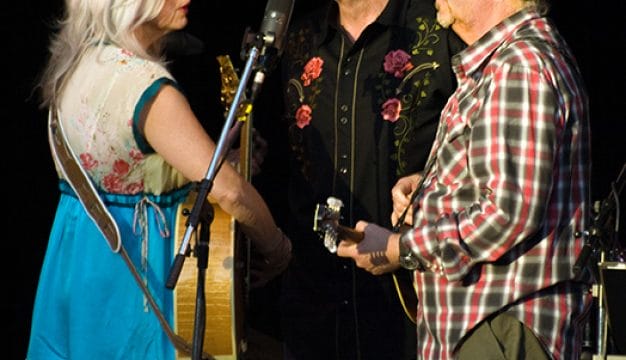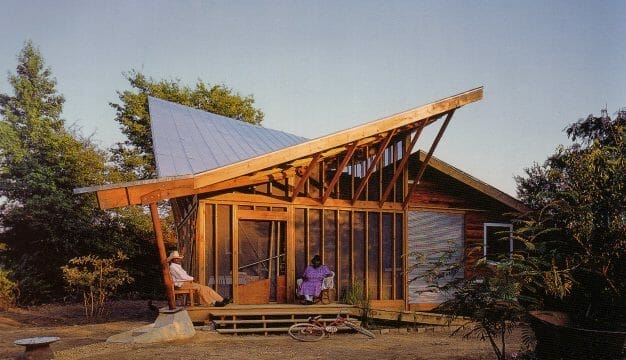Alabama Peach Industry
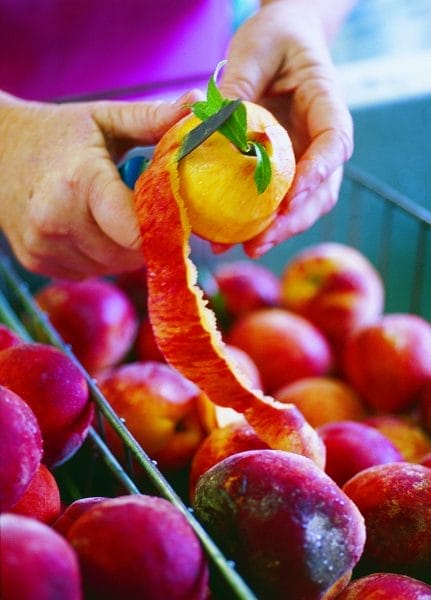 Chilton County Peaches
Peach growing in Alabama dates back to the mid-nineteenth century, and since that time the peach industry has provided growers with a viable source of income and alternatives to such traditional staples as cotton, corn, and other agricultural products. More than two-thirds of the cultivation has been confined to Chilton County, but the peach has become the state’s leading commercial fruit. The utilized yield for Alabama peach orchards in 2015 exceeded 11 million pounds and produced $6,182,000 from about 1,500 acres. The peach is celebrated with a festival in Chilton County and numerous recipes that incorporate the fruit.
Chilton County Peaches
Peach growing in Alabama dates back to the mid-nineteenth century, and since that time the peach industry has provided growers with a viable source of income and alternatives to such traditional staples as cotton, corn, and other agricultural products. More than two-thirds of the cultivation has been confined to Chilton County, but the peach has become the state’s leading commercial fruit. The utilized yield for Alabama peach orchards in 2015 exceeded 11 million pounds and produced $6,182,000 from about 1,500 acres. The peach is celebrated with a festival in Chilton County and numerous recipes that incorporate the fruit.
Early Enterprises
Peach growing thrived in the mid-Atlantic seaboard and in Georgia long before it came to Alabama. The earliest reference to peach cultivation in the state is from 1850, when Dr. H. V. Wooten of Lowndesboro, Lowndes County, reported planting five dozen peach trees. Soon after the Civil War Irishman John Howard Parnell, brother of famous Irish leader Charles Stewart Parnell, established a farm of nearly 1,500 acres in Chambers County, much of which he devoted to peaches. Parnell harvested his first crop in 1872 and eventually produced enough peaches to market his produce out of state. He also processed peach brandy for local consumption. Other early peach producers included Benjamin Winston Walker, who owned a plantation in Macon County, and politician Reuben F. Kolb of Barbour County, whose orchard of 2,000 trees yielded more than a bushel per tree. Kolb sold his produce for five to 20 dollars per bushel in northeastern markets during the 1880s.
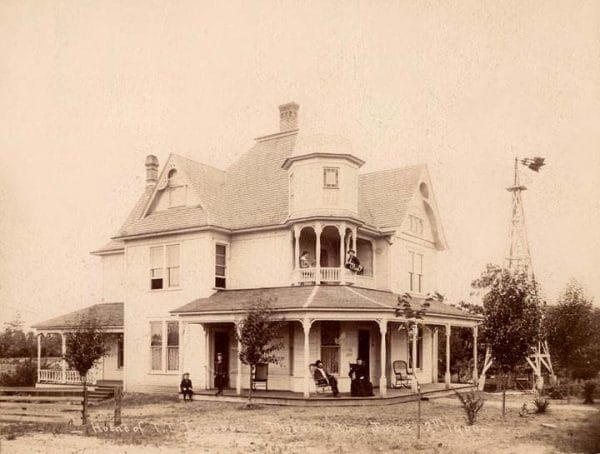 T. T. Thorson Home
The Alabama peach industry intensified with the arrival of Scandinavian immigrants Theodore Thorson and John Peterson, who established the settlement of Thorsby in 1895 in Chilton County. Peach trees were set as early as 1898, and the hilly landscape and climate seemed ideal for their cultivation. Although Georgian P. C. Smith was the first horticulturist to raise peaches commercially in Chilton County, it was the Scandinavians and other Thorsby growers who established a significant number of orchards, vineyards, and berry fields. Elberta was the variety of choice at the time, and Thorsby’s farmers set between 135 and 170 trees on their 10-acre plots, netting about 75 cents per crate (slightly more than a present-day bushel). After several successful seasons, the growers founded the Thorsby Fruit and Truck Growers Association and a cannery that employed 150 workers to promote and market their produce. Soon, however, there were setbacks to these promising developments. Statewide prohibition in 1908 forced local wineries to close, the town burned in 1914, and numerous peach trees were devastated by insects and disease, causing many original settlers to return to their original Upper Midwest homes. Thorson and Peterson moved to Madison County, Alabama, in 1910 and 1913, respectively.
T. T. Thorson Home
The Alabama peach industry intensified with the arrival of Scandinavian immigrants Theodore Thorson and John Peterson, who established the settlement of Thorsby in 1895 in Chilton County. Peach trees were set as early as 1898, and the hilly landscape and climate seemed ideal for their cultivation. Although Georgian P. C. Smith was the first horticulturist to raise peaches commercially in Chilton County, it was the Scandinavians and other Thorsby growers who established a significant number of orchards, vineyards, and berry fields. Elberta was the variety of choice at the time, and Thorsby’s farmers set between 135 and 170 trees on their 10-acre plots, netting about 75 cents per crate (slightly more than a present-day bushel). After several successful seasons, the growers founded the Thorsby Fruit and Truck Growers Association and a cannery that employed 150 workers to promote and market their produce. Soon, however, there were setbacks to these promising developments. Statewide prohibition in 1908 forced local wineries to close, the town burned in 1914, and numerous peach trees were devastated by insects and disease, causing many original settlers to return to their original Upper Midwest homes. Thorson and Peterson moved to Madison County, Alabama, in 1910 and 1913, respectively.
Some growers persisted in Chilton County and elsewhere, and with the introduction of pesticides and crop diversification encouraged by the ravages of the boll weevil on cotton, the state’s peach yield slowly began to increase. Total production in 1909, the earliest on record, was 1,417,000 bushels, reaching 2,640,000 by 1915, with an average annual output of 1,916,714 bushels selling at an average price of $.82 per bushel between 1909 and 1915. U.S. Department of Agriculture data indicate that most of Alabama’s peach acreage in 1910 was in the northeast part of the state, in DeKalb, Marshall, and Blount Counties, rather than Chilton. Alabama was never a leading peach-producing state, accounting for only about four percent of the national yield and trailing Georgia and Arkansas in the South by a wide margin. California, still the largest producer, led the nation, marketing more than three times the amount of peaches as its nearest rival, Georgia.
The Middle Period
 Pruning a Peach Tree
For the next several decades, Alabama’s peach output fell short of 1909–1915 averages. Yearly figures fluctuated greatly, but five-year averages showed little change from pre-war levels with 926,200 bushels (1920–24), 920,400 (1925–29), 1,401,200 (1930–34), and 1,494,000 (1935–39). Although the price per bushel started at a postwar high of $2.50 in 1920, five-year averages show a steady decline from $1.74 in the early 1920s to only $.95 in the late 1930s and a corresponding decline in total production values from $1,578,600 to $1,383,600 during the interwar period. Although peaches were the state’s leading tree fruit, accounting for about 6.33 percent of Alabama’s cash farm receipts (cotton was first at 65.5 percent), they trailed strawberries (at 6.66 percent). In 1938, a Chilton County extension service report stated that strawberries remained the principal truck crop, valued at $65,000, but noted that many thousands of peach trees had been planted during the previous three years in the area.
Pruning a Peach Tree
For the next several decades, Alabama’s peach output fell short of 1909–1915 averages. Yearly figures fluctuated greatly, but five-year averages showed little change from pre-war levels with 926,200 bushels (1920–24), 920,400 (1925–29), 1,401,200 (1930–34), and 1,494,000 (1935–39). Although the price per bushel started at a postwar high of $2.50 in 1920, five-year averages show a steady decline from $1.74 in the early 1920s to only $.95 in the late 1930s and a corresponding decline in total production values from $1,578,600 to $1,383,600 during the interwar period. Although peaches were the state’s leading tree fruit, accounting for about 6.33 percent of Alabama’s cash farm receipts (cotton was first at 65.5 percent), they trailed strawberries (at 6.66 percent). In 1938, a Chilton County extension service report stated that strawberries remained the principal truck crop, valued at $65,000, but noted that many thousands of peach trees had been planted during the previous three years in the area.
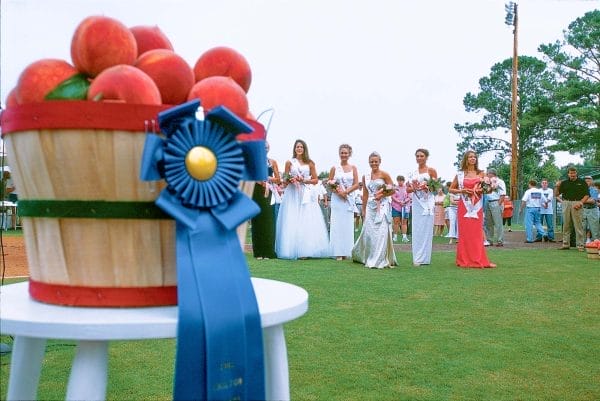 Peach Queen Pageant
The resulting bounty from these efforts soon brought about a resurgence of Alabama’s peach industry during the post-war years. In addition, Chilton County gained permanent notoriety as the peach capital of Alabama, producing more than 65 percent of the state’s peaches. The most immediate development was the staging of the first Peach Festival in Thorsby in 1947 after a bumper crop that year. The celebration featured a parade replete with a peach queen, speeches by dignitaries, picnics, peach-judging contests, concerts, orchard tours, a baseball game, and dance. The prize-winning peaches, grown by W. H. Lenoir, were delivered by Alabama’s senators to President Harry Truman. The festival moved to Clanton in 1952 and was later expanded to include Junior and Little Miss Peach contests, a 10-kilometer race, a peach cook-off, an art exhibit, a classic car show, and fireworks. The festival motto, “Chilton County Peaches are Tops,” eventually became a statewide slogan. The resurgence in the industry also led Auburn University to establish the Chilton Area Horticultural Substation (now the Chilton Research and Extension Center) near Thorsby in 1948. Improved pruning, spraying, and fertilizing techniques, as promoted by local extension agents, and a growing number of packing sheds seemed to indicate a promising future for the peach industry.
Peach Queen Pageant
The resulting bounty from these efforts soon brought about a resurgence of Alabama’s peach industry during the post-war years. In addition, Chilton County gained permanent notoriety as the peach capital of Alabama, producing more than 65 percent of the state’s peaches. The most immediate development was the staging of the first Peach Festival in Thorsby in 1947 after a bumper crop that year. The celebration featured a parade replete with a peach queen, speeches by dignitaries, picnics, peach-judging contests, concerts, orchard tours, a baseball game, and dance. The prize-winning peaches, grown by W. H. Lenoir, were delivered by Alabama’s senators to President Harry Truman. The festival moved to Clanton in 1952 and was later expanded to include Junior and Little Miss Peach contests, a 10-kilometer race, a peach cook-off, an art exhibit, a classic car show, and fireworks. The festival motto, “Chilton County Peaches are Tops,” eventually became a statewide slogan. The resurgence in the industry also led Auburn University to establish the Chilton Area Horticultural Substation (now the Chilton Research and Extension Center) near Thorsby in 1948. Improved pruning, spraying, and fertilizing techniques, as promoted by local extension agents, and a growing number of packing sheds seemed to indicate a promising future for the peach industry.
Despite these advances, however, yearly production averages plummeted during the 1950s to 600,150 bushels, down from 1,082,700 in the 1940s, including a total loss of the 1955 crop to a late frost. Peaches fell from 6 to 2 percent of Alabama’s cash farm receipts. Productivity picked up in the early 1960s, with production of 972,000 bushels in 1961 at an all-time high value of $3,080,000. New varieties, including Dixired and Loring, slowly displaced the Elberta trees, and the Alabama Farm Bureau Federation even began exploring possibilities for exporting peaches to Europe. Peach production in Chilton County peaked in 1960, when an estimated 800 producers shipped 478 railroad car lots of peaches grown on 10,000 acres. But by 1968 just 250 growers were farming only 3,500 acres. Statewide gross yields suffered a corresponding decline, from $2,619,000 to $1,441,000, during those years. In the early 1970s the Alabama market bottomed out at about 300,000 bushels.
The Modern Industry
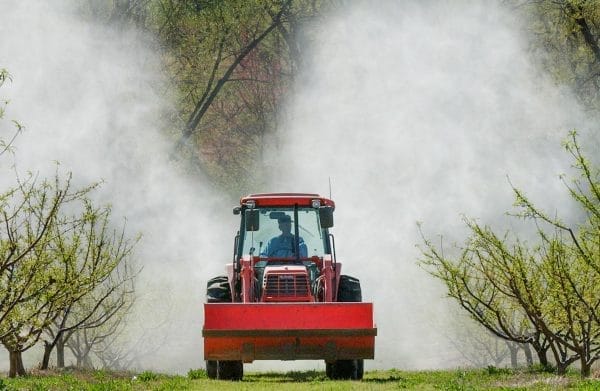 Spraying Peaches
To counter this decline, local farmers formed the Chilton County Peach Growers Association which became part of the Alabama Fruit Growers Association after 1979 and finally the Alabama Fruit and Vegetable Growers Association. State production was still only 394,710 bushels by 1979 and even after decades of double-digit inflation, peach farmers still were grossing only $4,277,000 by 1993. The industry stabilized somewhat in the early twenty-first century, averaging about 327,610 bushels (2000–04) and earning nearly $6,000,000 annually between 1994 and 2003. The 2004 crop in Chilton County, in excess of 15 million pounds (311,000 bushels), earned about $5,200,000. The number of peach farms decreased from 639 in 1997 to 379 in 2002 to 257 in 2012, and acreage devoted to peaches declined from 2,593 in 2007 to 2,012 acres in 2012. Virtually all of Alabama’s peach farms are family owned. Most farmers sell to local markets, but the five largest growers—Bentley, Durbin, Williams, Culp, and Patterson—also pack and ship their produce for out-of-state sale. Roughly 71.5 percent of the state’s production was centered in Chilton County in 2015, with Blount County running a distant second. Alabama produces roughly 1.5 percent of the nation’s peaches.
Spraying Peaches
To counter this decline, local farmers formed the Chilton County Peach Growers Association which became part of the Alabama Fruit Growers Association after 1979 and finally the Alabama Fruit and Vegetable Growers Association. State production was still only 394,710 bushels by 1979 and even after decades of double-digit inflation, peach farmers still were grossing only $4,277,000 by 1993. The industry stabilized somewhat in the early twenty-first century, averaging about 327,610 bushels (2000–04) and earning nearly $6,000,000 annually between 1994 and 2003. The 2004 crop in Chilton County, in excess of 15 million pounds (311,000 bushels), earned about $5,200,000. The number of peach farms decreased from 639 in 1997 to 379 in 2002 to 257 in 2012, and acreage devoted to peaches declined from 2,593 in 2007 to 2,012 acres in 2012. Virtually all of Alabama’s peach farms are family owned. Most farmers sell to local markets, but the five largest growers—Bentley, Durbin, Williams, Culp, and Patterson—also pack and ship their produce for out-of-state sale. Roughly 71.5 percent of the state’s production was centered in Chilton County in 2015, with Blount County running a distant second. Alabama produces roughly 1.5 percent of the nation’s peaches.
Of the many risks run by peach growers, bad weather is foremost, and it nearly destroyed the 1996 crop. Global heating is also a significant issue, with 2022 seeing only 772 “chill hours.” Peach trees require a certain number of cold days in order to set flowers and fruit, with the preferred minimum being around 850. Competition from California, which produces more than 75 percent of the nation’s peaches, remains a concern as well. Yields per acre sometimes triple those in Alabama. Labor is also a significant problem. Since the 1980s American workers have all but disappeared, and more than 90 percent of the workforce is migrant. Growers must not only pay a higher-than-minimum wage (dictated by the U.S. Department of Labor) but must transport workers from Mexico, pay border fees, provide housing, utilities, and workers’ compensation, and offer two weekly shopping trips. In return, migrants must work long hours—often seven days a week from April to September. Trees are also a major investment. Growers can expect an individual tree to produce for 11 seasons, but the key to maintaining success is to plant many (perhaps 20) varieties with staggered ripening times in order to ensure a steady flow of peaches to markets for as long as possible and to maximize the efforts of the labor force. Few Elbertas are grown anymore, but its first fruit (usually ripening around July 10) remains the gold standard by which the first harvests of all other varieties are timed for marketing.
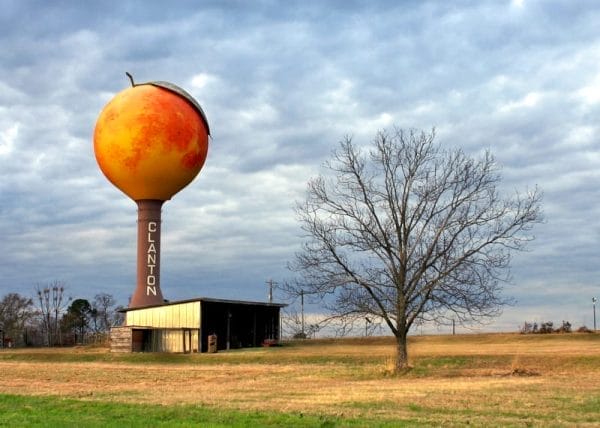 Clanton Water Tower
Despite diminishing profits, decreasing acreage, and fewer young people entering the industry, peach growers persist by using improved varieties, production, and marketing practices and by their dedication to a proud tradition. This pride in peaches is reflected not only in the continued popularity of Clanton’s annual peach festival but in various public enterprises that have sprung up along nearby Interstate 65. In 1961 Marvin Durbin set up the first roadside peach market, attracting travelers (including beach-goers and out-of-state visitors) along the busy stretch between Birmingham and Montgomery. In 1980 the Peach Park, founded by Gene Gray, opened with a restaurant, gift shop, pleasure-garden, and other amenities. In 1993 the city of Clanton constructed a 120-ft. peach-shaped water tower at Exit 212. The tower, which holds half a million gallons of water, is painted yellow and orange and features a drooping green leaf, stem, and suture. This striking symbol of Alabama’s peach industry demonstrates to passersby that while Georgia might be the peach state, Chilton is the peach county in Alabama.
Clanton Water Tower
Despite diminishing profits, decreasing acreage, and fewer young people entering the industry, peach growers persist by using improved varieties, production, and marketing practices and by their dedication to a proud tradition. This pride in peaches is reflected not only in the continued popularity of Clanton’s annual peach festival but in various public enterprises that have sprung up along nearby Interstate 65. In 1961 Marvin Durbin set up the first roadside peach market, attracting travelers (including beach-goers and out-of-state visitors) along the busy stretch between Birmingham and Montgomery. In 1980 the Peach Park, founded by Gene Gray, opened with a restaurant, gift shop, pleasure-garden, and other amenities. In 1993 the city of Clanton constructed a 120-ft. peach-shaped water tower at Exit 212. The tower, which holds half a million gallons of water, is painted yellow and orange and features a drooping green leaf, stem, and suture. This striking symbol of Alabama’s peach industry demonstrates to passersby that while Georgia might be the peach state, Chilton is the peach county in Alabama.
Further Reading
- Heritage of Chilton County, Alabama. Clanton, Ala.: Heritage Publishing Consultants Inc., 2000.
- Wyatt, T. E. Chilton County and Her People. Montevallo, Ala.: Times Printing Company, 1976.
